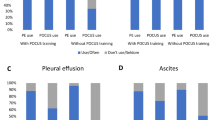Abstract
The authors prospectively evaluated the operating characteristics of the history and physical examination for ascites in a broad spectrum of hospitalized patients. The overall clinical evaluation produced a positive likelihood ratio = 37.7−83.3 when suggestive of ascites, a likelihood ratio = 2.23−3.42 when intermediate, and a negative likelihood ratio = 0.77 − 0.90 when not suggestive of ascites. Patients’ perceptions of increased abdominal girth (positive likelihood ratio = 4.16) or recent weight gain (positive likelihood ratio = 3.20) increased the likelihood of ascites. The absence of subjective ankle swelling (negative likelihood ratio = 0.10) or increased abdominal girth (negative likelihood ratio = 0.17) decreased the likelihood of ascites. The positive likelihood ratios for a fluid wave = 9.6 and shifting dullness = 5.76 favored ascites, while the absence of bulging flanks (negative likelihood ratio = 0.12) or peripheral edema (negative likelihood ratio = 0.17) favored ascites the least. Thus, a routine history and physical examination are quantitatively useful in the clinical evaluation of ascites.
Similar content being viewed by others
References
Lawson JD, Weissbein AS. The puddle sign: an aid in the diagnosis of minimal ascites. N Engl J Med 1959;260:652–4.
Cattau EL, Benjamin SB, Knuff TE, Castell DO. The accuracy of the physical examination in the diagnosis of suspected ascites. JAMA 1982;247:1164–6.
Cummings S, Papadakis M, Melnick J, Gooding GAW, Tierney LM. The predictive value of physical examinations for ascites. West J Med 1985;142:633–6.
DeGowin EL, DeGowin RL. Bedside diagnostic examination. 4th ed. Philadelphia: W. B. Saunders, 1981.
Neff CC, Simeone JE, Ferrucci JT, Mueller PR, et al. The occurrence of fluid collections following routine abdominal surgical procedures. Radiology 1983;146:463–6.
Goldberg BB, Goodman GA, Clearfield HR. Evaluation of ascites by utlrasound. Radiology 1970;96:15–22.
Goldberg BB, Clearfield HR, Goodman FA, Morales JO. Ultrasonic determination of ascites. Arch Intern Med 1973;131:217–20.
Simel DL, Feussner JR, DeLong ER, Matchar DB. Intermediate, indeterminate, and uninterpretable results. Med Decis Making 1987;7:107–14.
Feinstein AR. Clinical epidemiology. Philadelphia: W. B. Saunders, 1985;619–20.
Begg CB. Biases in the assessment of diagnostic tests. Stat Med 1987;6:411–23.
Greenes RA, Begg CB. Assessment of diagnostic technologies: methodology for unbiased estimation from samples of selectively verified patients. Invest Radiol 1985;20:751–6.
Author information
Authors and Affiliations
Additional information
Supported in part by the A. W. Mellon Foundation.
Rights and permissions
About this article
Cite this article
Simel, D.L., Halvorsen, R.A. & Feussner, J.R. Quantitating bedside diagnosis. J Gen Intern Med 3, 423–428 (1988). https://doi.org/10.1007/BF02595917
Issue Date:
DOI: https://doi.org/10.1007/BF02595917




